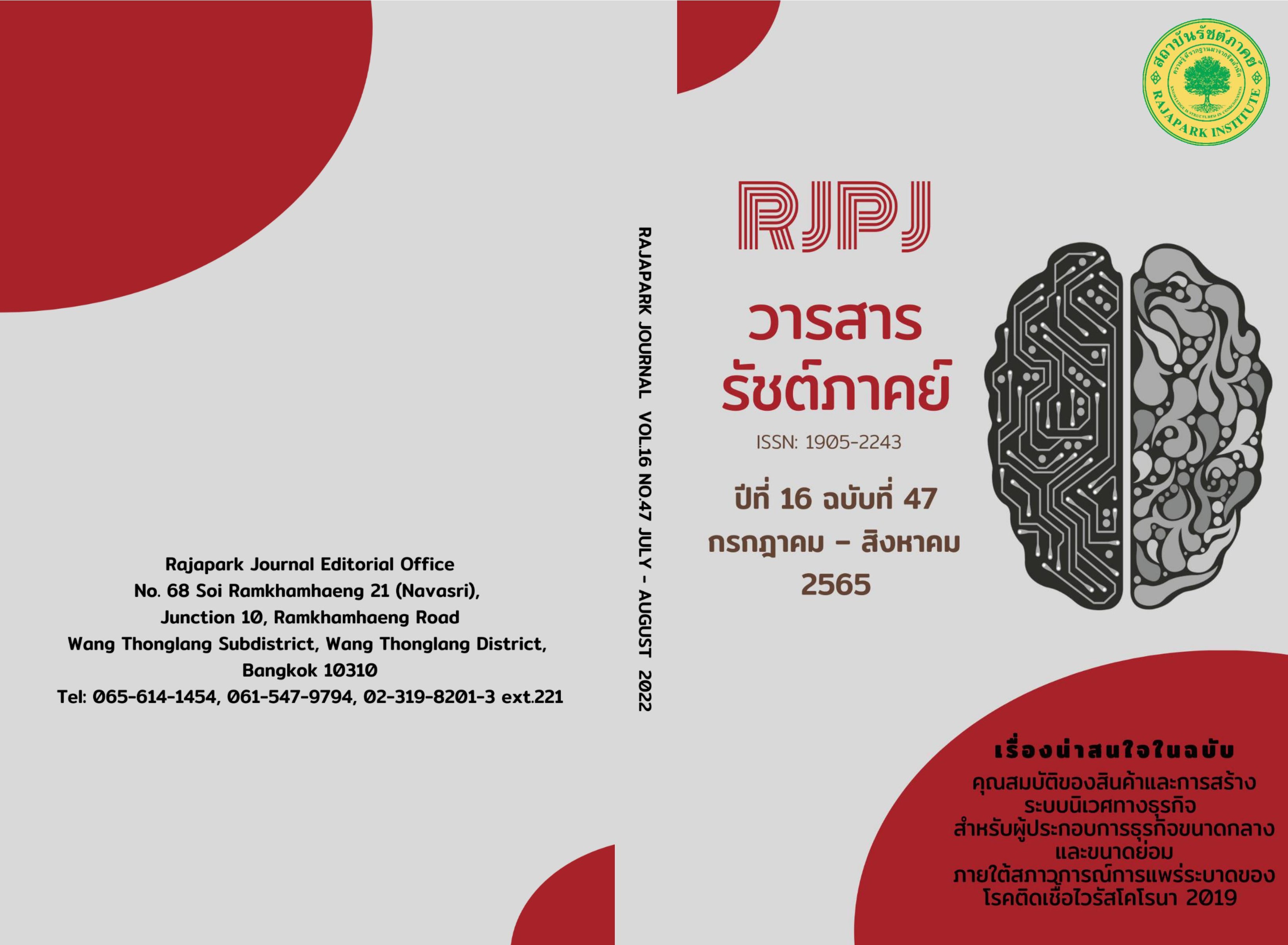Factors Influencing the Success of Thai Foreign Direct Investment in ASEAN under ASEAN Comprehensive Investment Agreement
Main Article Content
Abstract
This research aimed to study investment success of Thai enterprises in ASEAN, analyze core components of the ASEAN Comprehensive Investment Agreement, and examine factors influencing investment success of Thai enterprises in ASEAN by means of samples of 246 people randomly drawn from target population, including individuals in ASEAN direct investment companies. Data collected through reliability-tested questionnaire were analyzed by one way analysis of variance, multivariate analysis of variance, and multiple regression analysis. The findings revealed that there was no difference between either individuals or types of enterprises regarding success of an investment and core components of the ASEAN Comprehensive Investment Agreement. Factors affecting the success of an investment the most were related and supporting industries, then factor conditions, business chances, ownership advantages, demand conditions, government policy, and firm strategy, structure and rivalry, respectively.
Article Details

This work is licensed under a Creative Commons Attribution-NonCommercial-NoDerivatives 4.0 International License.
Views and opinions appearing in the Journal it is the responsibility of the author of the article, and does not constitute the view and responsibility of the editorial team.
References
Al-Habash, O., Mmieh, F., & Cleeve, E. (2017). Multinational Enterprises’ Entry Mode Strategies in Syria and Jordan: The Impact of Ownership Advantages. Thunderbird International Business Review, 59(6), 677-691. https://doi.org/10.1002/tie.21775
Arnett, D. B., & Madhavaram, S. (2012). Multinational enterprise competition: Grounding the eclectic paradigm of foreign production in resource-advantage theory. Journal of Business & Industrial Marketing, 27(7), 572-581. https://doi.org/10.1108/08858621211257347
Bayar, Y. (2014). Saving, Foreign Direct Investment Inflows and Economic Growth in Emerging Asian Economies. Asian Economic and Financial Review, 4(8), 1106-1122. https://archive.aessweb.com/index.php/5002/article/view/1239
Bezuidenhout, H., & Kleynhans, E. P. (2018). Modern Trends in Chinese Foreign Direct Investment in Africa: An OLI Approach. International Research Journal, 16(3), 279-300. DOI: 10.26493/1854-6935.16.279-300
Buckley, P. J., & Casson, M. C. (1976). The Future of the Multinational Enterprise. Palgrave Macmillan.
Chaisse, J., & Jusoh, S. (2016). The ASEAN Comprehensive Investment Agreement. Edward Elgar.
Cheewatrakoolpong, K. et al. (2014). Investment Opportunities and Barriers under the ASEAN Comprehensive Investment Agreement to Support the Entry into the ASEAN Economic Community (AEC). ONPA Company Limited.
Chen, T.-J., & Ku, Y.-H. (2000). The Effect of Foreign Direct Investment on Firm Growth: The Case of Taiwan’s Manufacturers. Japan and the World Economy, 12(2), 153-172. DOI:10.1016/S0922-1425(99)00035-3
Chung, T. W. (2016). A Study on Logistics Cluster Competitiveness among Asia main Countries using the Porter’s Diamond Model. The Asian Journal of Shipping and Logistics, 32(4), 257-264. https://doi.org/10.1016/j.ajsl.2016.12.010
Dunning, J. H. (1993). Multinational Enterprises and the Global Economy. Addison Wesley.
Dunning, J. H. (2001). The Eclectic (OLI) Paradigm of International Production: Past, Present and Future. International Journal of the Economics of Business, 8(2), 173-190. https://doi.org/10.1080/13571510110051441
Dunning, J. H. (2013). International Production and the Multinational Enterprise. Routledge.
Fang, K., Zhou, Y., Wang, S., Ye, R., & Guo, S. (2018). Assessing National Renewable Energy Competitiveness of the G20: A Revised Porter’s Diamond Model. Renewable and Sustainable Energy Reviews, 93, 719-731. DOI: 10.1016/j.rser.2018.05.011
Görg, H., & Greenaway, D. (2003). Much Ado about Nothing? Do Domestic Firms Really Benefit from Foreign Direct Investment? IZA Discussion Paper No. 944. The Institute for the Study of Labor.
Irfan, M. et al. (2019). Critical Factors Influencing Wind Power Industry: A Diamond Model Based Study of India. Energy Reports, 5, 1222-1235. https://doi.org/10.1016/j.egyr.2019.08.068
Khazanie, R. (1996). Statistics in a World of Applications. Harper & Collins.
Kinoshita, Y., & Lu, C.-H. (2006). On the Role of Absorptive Capacity: FDI Matters to Growth. William Davidson Institute Working Paper No. 845. University of Michigan.
Loewendahl, H. (2001). A Framework for FDI Promotion. Transnational Corporations, 10(1), 1-42. https://www.usacompetes.com/wp-content/uploads/sites/7/2018/04/WAVTEQ_A-Framework-for-FDI-Promotion.pdf
Mottaleb, K. A., & Kalirajan, K. (2010). Determinants of Foreign Direct Investment in Developing Countries. The Journal of Applied Economic Research, 4(4), 369-404. DOI: 10.1177/097380101000400401
Nair-Reichert, U., & Weinhold, D. (2001) Causality Tests for Cross-Country Panels: New Look at FDI and Economic Growth in Developing Countries. Oxford Bulletin of Economics & Statistics, 63(2), 153-171. https://doi.org/10.1111/1468-0084.00214
Nikomborirak, D. et al. (2007). Project on the Role of Multinational Corporations in Thailand. The Thailand Research Fund.
Penrose, E. T. (1956). Foreign Investment and the Growth of the Firm. Economics Journal, 66(262), 220-235. doi:10.2307/2227966
Porter, M. E. (1990). The Competitive Advantage of Nations. MacMillan.
Rashidin, M. S., Javed, S., Chen, L., & Jian, W. (2020). Assessing the Competitiveness of Chinese Multinational Enterprises Development: Evidence from Electronics Sector. SAGE Open, 10(1), 1-20. https://doi.org/10.1177/2158244019898214
Thatpitakkul, S. (2016). 50 years of BOI: Development of Investment Promotion. Investment Promotion Journal, 27(1), 13-19. https://www.boi.go.th/upload/content/BOI_ Jan59_84418.pdf
The Stock Exchange of Thailand. (2020). Report on Foreign Direct Investment of Companies Listed on The Stock Exchange of Thailand in 2019. The Stock Exchange of Thailand.
Thongrompo, T. (2011). Analysis of 2009 ASEAN Comprehensive Investment Agreement: Study on Development of ASEAN Investment Liberalization and the Advisability for Thailand to Become Its Party[Master’s Thesis, Thammasat University].
UNCTAD. (2021). World Investment Report 2021. United Nations.
Vernon, R. (1966). International Investment and International Trade in the Product Cycle. Quarterly Journal of Economics. 80(2), 190-207. https://doi.org/10.2307/1880689
Williamson, P., & Wan, F. (2017). Emerging Market Multinationals and the Concept of Ownership Advantages. International Journal of Emerging Markets, 13(3), 557-567. https://doi.org/10.1108/IJoEM-08-2017-0319


